Zadoc P. Dederick's Steam Man appears to be the first of the Steam Men. The Steam Man from Newark was so inspirational it generated many more Walking Machines, steam or otherwise, and also fictional stories, now seen as some of the earliest Science or Speculative Fiction (SF) written.
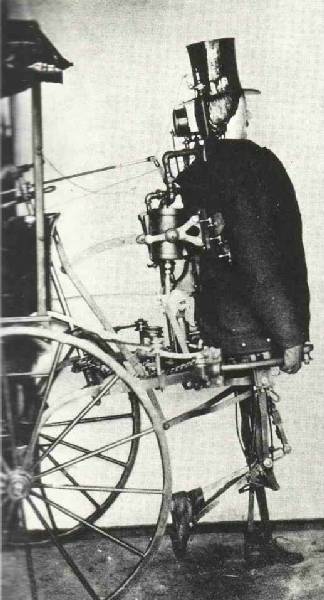
US Patent number: 75874
Issue date: Mar 24, 1868
Inventor: ZADOC P. DEDERICK & Isaac Grass
The name of the co-inventor on the patent is Isaac Grass, but he rarely gets a mention in any of the press.
Dederick's name is often mispelt e.g. Deddrick in the newspapers and Drederick on the patent. The name Dederick is from the German "Dietrich", which is probably responsible for how it is pronounced. Even in one census document, Dedrick has been corrected to Dederick. Like a lot of name changes throughut history, it is down to the interpretation of the scribe. Further, Dederick, in his three found patents, as well as on patents where he was a witness and/or the Patent Attorney (yes, he became a bona fide Patent Attorney), he always spelled his first name as Zadoc, whereas other official documents have him as Zadock, Later, he moved to the convention of initials only i.e. Z.P. Dederick. Although I've seen no direct evidence that his middle initial of "P." stands for Pratt, there are several other Z.P. Dedericks of which Pratt is the second name. Note that their first names are spelled Zadock (with a k).
See Joseph Rainone's book "Art & History of American Popular Fiction Vol 1." for a more complete story on Dederick's life.
I have used 1867 as the date for Dederick's Steam Man, as although the patent and most other articles are 1868, the first full article appeared in the Newark Advertiser, Jan 8 1868, so the Steam Man had to have been built before then. Here's the full reference and the OCR'd text:
Deddrick Steam Man
A Remarkable Mechanical Invention — A Steam Man.'-
Mr. Zadock Deddrick, a Newark machinist, has invented a man; one that, moved by steam, will perform some of the most important functions of humanity; that will, standing upright, walk or run as he is bid, in any direction, and at almost any rate of speed, drawing after him a load whose weight would tax the strength of three draught horses. The history of this curious invention is as follows: Six years ago Mr. Deddrick, the inventor, who is at present but twenty-two years of age, conceived the novel idea of constructing a man that should receive its vitality from a perpetual motion machine. The idea was based on the well-known mechanical principle that, if a heavy weight be placed at the top of an upright slightly inclined from vertical, gravitation will tend to produce a horizontal as well as vertical motion. The idea was unsuccessful. However, by observing carefully the cause of failure, persevering and perfecting the man-form, and by substituting steam in place of the perpetual motion machine, the present success was attained.The man stands seven feet and nine inches high, the other dimensions of the body being correctly proportioned, making him a second Daniel Lambert, by which name he is facetiously spoken of among the workmen. He weighs five hundred pounds. Steam is generated in the body or trunk, which is nothing but a three-horse power engine, like those used in our steam fire engines. The legs which support it are complicated and wonderful. The steps are taken very naturally and quite easily. As the body is thrown forward upon the advanced foot the other is lifted from the ground with a spring and thrown forward by the steam. Each step or pace advances the body two feet, and every revolution of the engine produces four paces. As the engine is capable of making more than a thousand evolutions a minute, it would get over the ground, on this calculation, at the rate of a little over a mile a minute. As this would be working the legs faster than would be safe on uneven ground or on broad street cobble stones, it is proposed to run the engine at the rate of five hundred revolutions per minute, which would walk the man at the modest speed of half a mile a minute.
The fellow is attached to a common rockaway carriage, the shafts of which support him in a vertical position. These shafts are two bars of iron, fastened in the usual manner to the front of the carriage, and are curved so as to be joined to a circular sustaining bar, which passes around the waist, like a girth, and in which the man moves so as to be faced in any direction. Besides these motions, machinery has been arranged by which the figure can be thrown backward or forward from a vertical nearly forty-five degrees. This is done in order to enable it to ascend or descend all grades. To the soles of the feet spikes or corks are fixed, which effectually prevent slipping. The whole affair is so firmly sustained by the shafts and has so excellent a foot-hold, that two men are unable to push it over, or in any way throw it down. In order to enable it to stop quickly it is provided with two appliances, one of which will, as before stated, throw it backward from the vertical, while the other bends the knees in a direction opposite to the natural position.
An upright post, which is arranged in front of the dash-board, and within easy reach of the front seats, sustains two miniature pilot wheels, by the turning of which these various motions and evolutions are directed. It is expected that a sufficiently large amount of coal can be stowed away under the back seat of the carriage to work the engine for a day, and enough water in the tank under the front seat to last half a day.
In order to prevent the “giant” from frightening horses by its wonderful appearance Mr. Deddrick intends to clothe it and give it as nearly as possible a likeness to the rest of humanity. The boiler, and such parts as are necessarily heated, will be encased in felt and woolen undergarments. Pantaloons, coat and vest, of the latest styles, are provided. Whenever the fire needs coaling, which is every two or three hours, the driver stops the machine, descends from his seat, unbuttons “Daniel’s” vest, opens a door, shovels in the fuel, buttons up the vest and drives on. On the back, between the shoulders the steam cocks and gauges are placed. As these would cause the coat to set awkwardly, a knapsack has been provided that completely covers them. A blanket, neatly rolled up and placed on top the knapsack, perfects the delusion. The face is molded into a cheerful countenance of white enamel, which contrasts well with the dark hair and mustache. A sheet iron hat with a gauge top acts as a smoke stack.
The cost of this “first man” is $2,000 , thought the makers, Messrs. Deddrick & Grass, expect to manufacture succeeding ones, warranted to run a year without repair, for $300. The same parties expect to construct, on the same principle, horses which will do the duty of twelve ordinary animals of the same species. These, it is confidently believed, can be used alike before carriages, street cars and plows. The man now constructed can make his way without difficulty over any irregular surface whose ruts and stones are not more than nine inches below or above the level of the road.
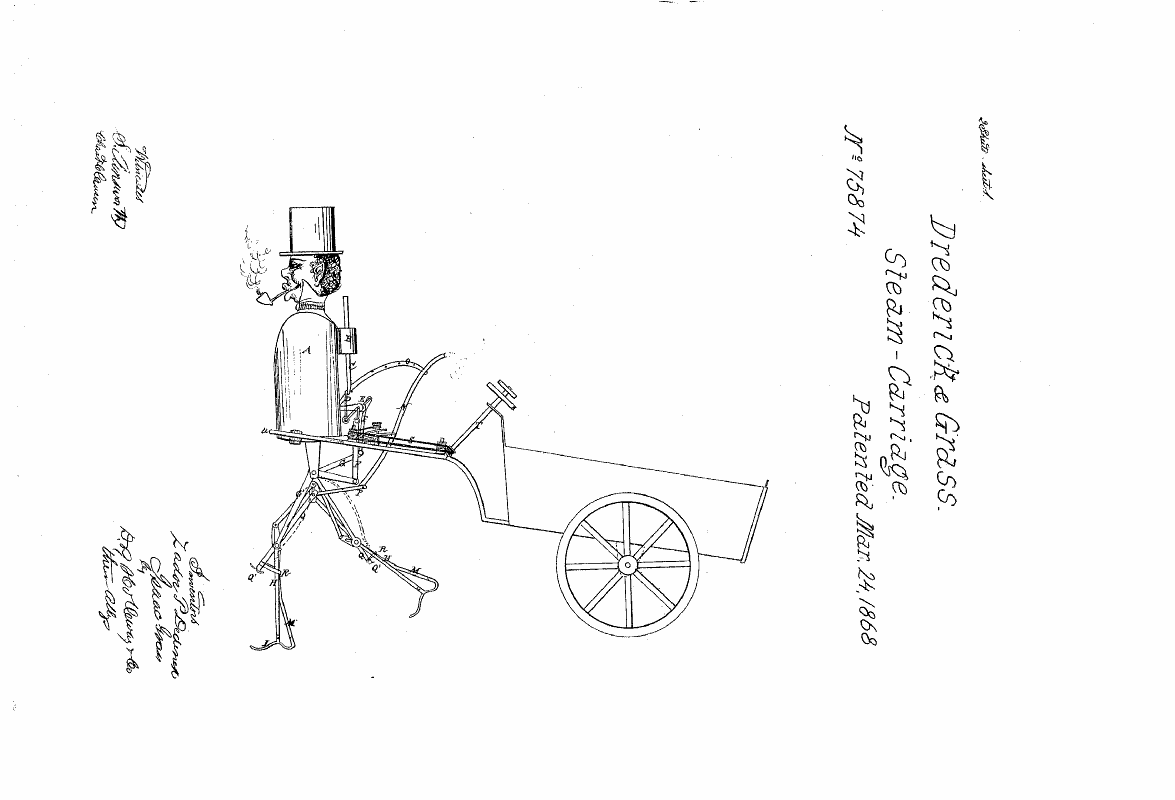

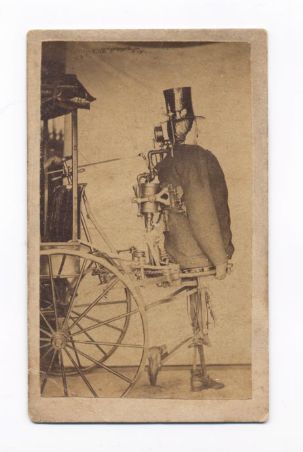
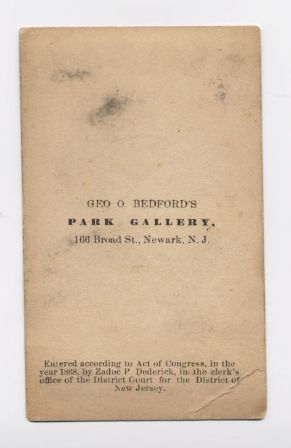
It has been difficult in getting the full story around Dederick's Steam Man. Did it actually work? As far as whether or not it worked, the press of the time offers some contradictory evidence. It did work, but only in ideal conditions. It struggled on cobblestones, and was sometimes exhibited suspended off the ground by a sling, mainly due to conditions put on the exhibtion by the insurers.
New York Times 19 Apr 1896 p28
THE HORSELESS CARRIAGE WILL THE PROBLEM BE SOLVED BY ELECTRICAL APPLICATION
……………
An inventor of Newark, N. J., about 1868 created excitement by bringing out a steam man that was to be placed in front of a carriage, and run along with it at racing speed. But it never ran, although it could be made to work its legs when hung up in the air.There are so many objections to the use of steam for carriages or even ordinary business wagons that it is difficult to see how it can be made successful, but the inventors working on that line evidently have hopes, for they are attacking the problem with increasing energy. When one considers the care and attention a small steam engine requires, ….
Scientific American was interested, but didn't get far with it…
Scientific American Vol 17. No. 5 p74 1868
STEAM MAN.-A lengthy account is going the round of the newspapers of a wonderful piece of mechanism in the form of a " Steam Man," invented at Newark, N. J., by one Zaddock Deddrick. We have taken the pains to investigate the truthfulness of the wonderful story and we learn that, although an invention of the kind is in progress, it is far from being perfected ; and we have the promise that as soon as the steam man is in a condition to travel we shall have an opportunity of witnessing it, and the liberty of explaining its construction and operation. In the mean time we advise our contemporaries not to get excited over the steam man for he is likely to remain harmless for the present.
Scientific American Vol 18. No. 13 p202 1868
The Steam Man.
This automaton, which has furnished a number of pant- graphs for the press, is on exhibition at 538 Broadway, New York City, nearly opposite the site of Barnum's Museum ; but owing to some objection on the part of the owner of the hall, he is not permitted to " travel on his muscle," but is hung in slings and merely " marks time," as our military friends would say. We understand, however, that his managers have decided to test his powers more effectually, when we shall probably have more to say of him. (see actual image above)
Of a later Steam Man, the report is …
Tuapeka Times, Volume III, Issue 134, 1 September 1870, Page 7
GENERAL NEWS.There is now on exhibition in New York a " steam man " which actually walks — not merely performs with the legs the movements necessary for walking, while the body is suspended on a fixed support like the old " steam man" which made so much noise about two years ago, and which, we suppose, is now defunct. It was claimed for the old steam man that it was to be used for traction and other useful purposes ; but the new one commences its career with no such pretensions. All that is claimed for it is that it makes an interesting exhibition. It has the same walking mechanism as the clockwork walking dolls patented some years ago. The mechanism is driven by one of Behren's rotary steam engines, which has been found better suited than any reciprocating engine on account of its producing less vibration, and consequently being less liable to disturb the equilibrium of the man in the walking movement. As an ingenious piece of mechanism, the walking steam man is an object of interest.
Update 17 March 2010 – I contacted the Newark Museum who supplied the following:
I did not find any record of an exhibition of this type ever being held at the Museum. We do have a photograph in the collection labelled: "Mechanical man. Invented by Zadoc P. Dederick in 1868. Made under his supervision in a machine shop operated by Bolen and Crane on Broad St. near Cross St." According to our Registrars Department this appears to be a copy of the patent photo. Also, according to the Newark City Directory, a Zadoc P. Dederick, occupation patternmaker, resided at 87 Spring St. off of 105 River in Newark, NJ in 1868.
from The Morning Chronicle 27Jan1868- Nova Scotia
The above article confirms that the building of the Steam Man was at the works of Bolen & Crane.
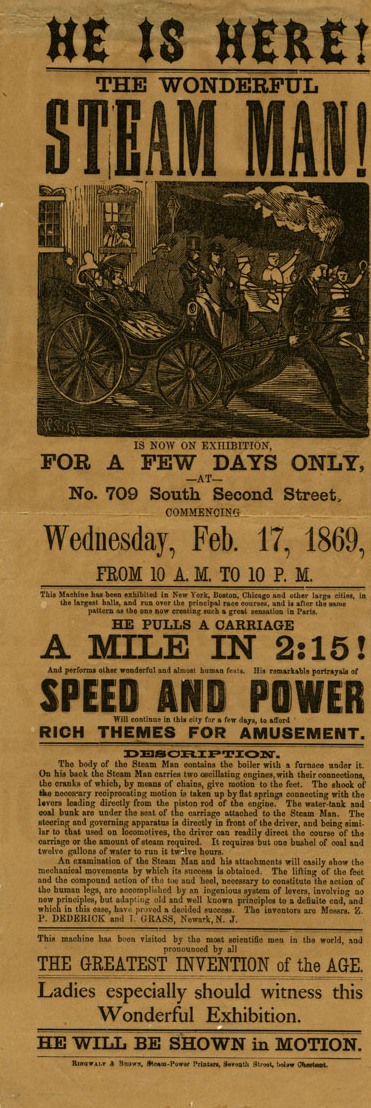
The text in the above advertisement suggests another Steam Man was built to the same pattern and currently exhibiting in Paris, but no evidence of this Parisienne has been found.

The above two images sourced from here: http://processandpreserve.wordpress.com/2009/09/23/wont-you-step-into-this-cloud-of-steam/
The above ad, from The Quincy, in Quincy, Illinois, 20 Feb 1869 suggests that the Steam Man had already been exhibited in New York, Boston, Chicago, St. Louis and New Orleans.
.jpg)
article from THETRUE BLUES OF SCHENECTADY
Originally written by Reverand W.N.P. Dailey and Read Before the Antiquarians at the Schenectady County Historical Society in 1940…A social order known as the “True Blues” was organized in July 1867, and chartered in March 1869.
The press of Schenectady and Albany and adjacent cities devoted much space detailing the parades, the concert and the bazaar held during these years. Also the “New York Herald” and “Frank Leslie’s News” featured the various events conducted by the mystic order.
The second carnival and parade of the Mystic Order of the True Blues was held on Thursday afternoon Sept 3, 1868. The “Albany Post” of September 4, 1868, says there were 20,000 visitors in the city. The Albany papers, the “Journal”, “Argus” “Express” and “Post” devoted much space to a description of the same.
The “New York Herald” featured the event while “Leslie’s Illustrated Weekly” showed a half page picture of the procession, reproduced in the “Union” as the parade, (or part of it” halted before the building occupied by the “Union”, and also the Carley House next door. Four hundred and fifty costumes; Charles Campbell, in Roman Chariot, a brilliant equipage, led the same.…..The Parade, a mile long, was started at 3 p.m. Those who were masked waited till the public dinner at the Carley House and Givens Hotel to remove them.
The Grand Marshall and his aides followed the Roman Chariot, built by Antonius, holding the God of the Day: they were dressed in the costume of the period of Charles II; after them a giraffe, sixteen feet high from Gouriel, “trained by Prince Van Horne, the first Euker of America.” No-olah, the baby elephant, was well behaved, sturdy but fierce looking pioneers were guarded by a burlesque police force, commanded by an artillery officer in Revolutionary uniform, the property of Colonel Campbell. Burlingame’s traveling Chinamen came next, followed by Neptune drawn by bespangled horses led by silver bedecked grooms. It made me think of a Roman myth. Beasts of the field and birds of the air were represented.
Ladies astride dappled equines received the crowd’s cheers. There was a human steam engine – eight feet high with stove pipe hat for smoke, fitted up with furnace and piston rods, and wheel at the side for extra power. We recall that at a certain point in the parade, the engine got too hot and had to be removed to save the human from incineration. Another feature we recall, but not mentioned in the press descriptions was great dray containing a hogshead of beer. Seated in front was a saloon keeper who held forth at or near Liberty and Center Streets of large proportions: gaily dressed maidens drew the ale from the hogshead and gave it to the man to drink. At the close of the parade he had to be skidded into his place.
…….Following the concert, the next day, came the final parade of the True Blues, September 7, 1870……Some of the features of this parade were an old Franklin press worked by comically dressed pressmen and a printer’s devil and two female compositors “sticking type”. The Alaska purchase by Seward (a proven diamond mine) in the form of an ice berg, lambasted the government’s investment. Ed Vrooman had a swaying “Albany-Schenectady R. R. train” (hauled by horses) passengers masked , who kept leaving and boarding their cars while in motion. Neptune was again shown, this year its headquarters being at Neptune Engine Company Number 4. A model of the Neptune float is at the historical society. There was another steam man eight feet high, and the giraffe came out again with its sixteen feet height. A yacht club was in sailor garb; a sprinkling cart hauled by Susan B. Anthony (incognito); heat and cold were shown in costume representing fire and frost; . …….
The last we know of Dederick's Steam Man being exhibited was in Fort Wayne, Indiana in May of 1869.
There is an advertisement in September, 1869 of a Steam Man for sale. There is another article in April of 1870 that mentions a Steam Man being stowed away for non-payment of freight.
Was that the end of Dederick's Steam Man? Was it sold and re-incarnated as the W.W. Cole's circus Steam Man? Unfortunately we currently do not know for sure, but I suspect not.
See all the known Steam Men and early Walking Machines here.
GREAT JOB! GREAT RESEARCH! It does not appear you have my book THE ART & HISTORY OF AMERICAN POPULAR FICTION SERIES VOL.1 which has a chapter devoted on Dederick and his invention.
I was not aware of the 1869 image and article…fantastic! It does fit my theory that Zadoc took to the road to display his invention. I beleive he may have been with the Cole Circus in 1870.
Anyway, just wanted to comment on how much I enjoyed your work here…
Also, I would like to see that 1867 article…now that is even more suprising….thanks again.
Joe Rainone